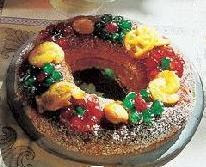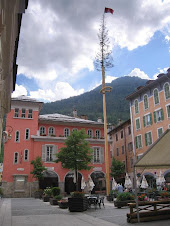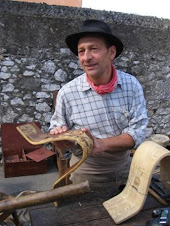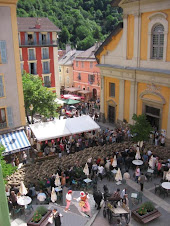For French people, Christmas is like Thanksgiving for the Americans, it is the time when family gathers. In the North and North East of France, children are given gifts at St Nicolas on Dec 7th but in the South, Pere Noel (Santa Claus) brings them on the night of Dec 24th. He comes from Lapland on a slide driven by elks and goes down the chimney. Santa Claus is dressed differently than in the States, instead of red trousers and a jacket, he wears a long red gown bordered with white fur. He carries the toys in a straw basket in his back (like people who collect grapes) and leave them in shoes near the fire place or under the fir tree (not in socks as in the US). Of course, on Dec 24th, all the kids polish their shoes in order they are so shiny that they attract more toys!
If the kids have not been nice all over the year, Père Fouettard comes instead of Pere Noel and gives them a spanking instead of toys.
The fir tree is also decorated very differently than in the States. The fir tree was created in Alsace in North-East of France. At that time it was suspended to the ceiling and decorated with apples. When Alsace became German, the fir tree was adopted all over Germany and then to France when Hélène de Mecklembourg brought one to Paris after marrying the Dauphin, e.g. the French heir to the throne.
Normally you must prepare the Xmas tree only on Dec 23rd and it must last until Epiphany on January 7th, the anniversary of the visit of the three wise men to Jesus. However people set it up as early as end of November. As it is more & more often in plastic, it can last for until end of the year.
In general for the diner, France used to have turkey but now they prefer to have more refined food and generally they buy the most expensive food they cannot afford the rest of the year. Typically they eat oysters (raw), smoked salmon, foie gras (goose liver), lobster, boudin blanc (milk and bread, pork and veal sausage) . . . and for dessert the traditional Buche de Noël, log cake.
It is a ‘genoise’ cake (sponge cake), which is rolled and shaped as a log. It is stuffed inside with a butter based cream and it is covered by a mix of chocolate & chestnut puree to make it look like a log.
Nowadays Buche de Noël comes in all types such as iced cake but they still have the look of a log.
The log is a very ancient symbol associated with Christmas time.
Christmas dates from before Christianity. It was celebrating winter solstice. At that time people were animist and believed that some trees have special powers and can transmit their strength to humans. They will take a log from a living fruit tree. Part of the log was burnt and burning slowly for a long time was a good sign for harvest.
Then some ashes will be kept in the house to protect it from lightening; the other part was used to make the wedge for the plough as a good luck talisman for the coming harvest.
To avoid turmoil, clergymen were clever to turn this celebration into a Christian rite.
Unlike in the rest of France where it appeared for commercial reasons, the Xmas markets are a true tradition in Alsace (North East) and in Provence, the opportunity for craftsmen and peasants to sell home made craft or cooking preparation (anchoiade with anchovies, tappenade with olives, aioli with garlic, fruit or flower jams, glazed chestnuts, crystallized fruits, dry meat, preserves, …).
We have our own Xmas customs in Provence.
We celebrate "Calendale" i.e. advent lighting up a large white candle each 3 Sundays before Christmas. We do not have a special calendar nor the wreath as in the Anglo-Saxon countries though.
The first Calendale rite is planting a few lentils or wheat seeds in wet cotton on Ste Barbe day (Dec 4th). Their growth is a symbol for fertility of the earth and brings prosperity to the family (Quand lou blad vèn bèn, tout vèn bèn!). When Provence people set up the ‘creche’, a miniature nativity scene, they decorate it with the germinated grains next to Jesus' crib to have a good harvest in the coming year.
St Francis of Assisi is said to have been the first to make a Creche at Christmas in 1223. The tradition of having a Creche at Christmas spread up in Italy then in Provence and much later all over France.
The other Provence tradition is to decorate the ‘creche’ with ‘santons’ (little saints), clay figures dressed in traditional Provence clothes holding tools of their jobs. Their making (size and attire) is codified; each character must be made according to strict rules. There are many dedicated fairs and Christmas markets where you can find little cheap ones, which are just painted, or elaborated ones, bigger and with real clothes making wonderful gifts as they are always authentic and gaily coloured.
The patterns for the moulds have been passed from generation to generation since the seventeenth century.
In addition to the usual Holy Family, angel and shepherds (pastres), in Provence we add the important people of the village in the "creche", sculpting the faces according to persons living in the village .
You have the mandatory ones such as shepherds carrying a baby lamb on their shoulders, "ravi" e.g. the idiot of the village raising his hands to the sky, "garde champêtre" a kind of policeman watching poachers and making public announcements with his drum or clarion, “tambourinaire”, the traditional musician with his galoubet and tambourin, "miller" who grounds the corn or olives, "fisherman" with his net, “peasant” with baskets full of fruits and veggies, "hunter" bringing a hare, "baker" with a basket full of breads, , the grinder, the sweep, the farm servant Bartoumieù… but you have also the farmer's wife, the priest, female "fish seller", "garlic seller", "Margarida" with her umbrella, "pig man", female "snails seller", female "bundles of sticks seller", "gypsy“ (Lou Boumian), “blind beggar”, "pitcher seller", “Arlesienne” in her beautiful attire, Pistachiet, Jiget , Roustido…
The ‘creche’ reminds us that Christmas is the celebration of Jesus’s birth before being the most popular family fest. The santons make each of the villagers being part of this miracle. It is undone on Chandeleur day (see further down).
During Advent, we have also live nativity scenes were human and real animals are playing the roles of the different characters of the nativity scene.
Pastorales re-enact the scenes of the birth of the Christ mixed with sketches from Provence legends full of typical Provence characters such as le Ravi, an half-witted man, Mireille and Vincent, two lovers who cannot get married because the young man is not rich enough... It is mainly dances and songs with a little of text in Provence language (not a dialect but a language recognised by the European Parliament) but it is expressive enough to be understandable. The whole show is very colourful.
In Provence people share traditionally the Gros Souper before they go to the mass service at midnight (in the old time people will wait after the midnight service to have the Gros Souper because you had to have an empty stomach to receive the communion and there is a famous tale about that which was written by Alphonse Daudet in ‘letters from my mill’, one of the most famous Provencal books).
The table is covered with three white table clothes laid one on top of the other, symbolizing the Holy Trinity (Catholics believe that God is a 3 part entity: God, his son Jesus & the Holy Spirit), the three Advent candles in a three-branch candlestick , symbolizing past, present and future (one candle for ancestors, one candle for relatives and friends, one candle for children to be born) and three dishes with Ste Barbe wheat, hoping that it had grown very green and straight as it symbolizes future harvests. An additional place is laid for the poor who may knock on the door and whom we cannot chase as Jesus’s parents were sent away.
Before the diner, there is the traditional « cacho-fio », the lighting of the fire.
In accordance with the pagan symbolism of the log, the eldest (Papet) and the youngest (Pichot) tour the room 3 times with a log from an olive or cherry tree; then they put it in the fireplace, the elder pours a glass of red wine 3 times over it to extinguish the fire of the past year and re-sets the fire up saying
ALEGRE! ALEGRE! DIEU NOUS ALEGRE! EME CALENDO! TOU BEN VEN! DIEU NOUS FAGUE LA GRACI DE VEIRE l’AN QUE VEN! E SE NOUN SIAN PAS MAI, QUE NOUN FUGUEN PAS MENS!
(Gloria! Gloria! Xmas is now! That’s great! Let’s wish that God let us see next year; should we not be more, let’s not be less)
The audience shouts « Cacho-fio! Bouto fio! » as an answer.
The log must slowly get consumed until Epiphany (JanUary 6th), thus it must be big & young.
The diner must be prepared with only local simple produces and be meagre i.e. meat free. It includes 7 courses (as many as Marie’s labour pains) with local and in-season vegetables often accommodated as Tian and fish. You can find some of them only in Provence such as ‘cardons’, and kinds of fish which are from the Mediterranea and must always include cod accommodated in different ways such as ‘brandade’ (salted cod pounded with smashed potatoes, garlic, olive oil and cream) and Raïto (salted cod in Raïto Sauce).
After Gros Souper, a long procession with people in traditional attire, tambourinaires & shepherds with their sheep (Pastrage) go to the church and gather before the mass service to sing traditional songs, this is still very alive in little villages of the French Riviera beyond country (arriere pays).
You should have at least:
- the 4 ‘beggars’ representing the four religious orders begging for their food:
- Almonds for the Carmelites
- Dried figs for the Franciscans
- Raisins for the Dominicans
- Walnuts/hazlenuts for the Augustins
- Pompe à huile: all our cuisine is based on olive oil, which is produced in water mills from November until March. The miller puts flour in the bottom of the press to absorb the remaining oil. Women bake this soaked flour added with orange blossom water to get the Pompe a Huile cake. The shape of the cake is a wheel symbolizing the cosmic forces.
- Fougasse (a cake with anis flavor),
- Auribeto or Oreillettes (thin fried cakes),
- Navettes (dry cakes with almonds),
- Black and white (as a symbol of good and bad days) Nougat (candy made of honey, almonds …), symbolizing Black and White Penitents
- Quince, nuts, rhubarb… jam,
- Papillottes (chocolates sweets wrapped in silver paper),
- Disguised fruits such as prunes with almond pasta,
- Fresh local fruit: apples, pears, oranges, winter melons, grapes, kakis, grenades,…
- Dates symbolizing the country where the Christ is born; in Provence they are of gold colour, so they are called Pistoles like the ancient Spanish gold coins
- Plus local specialities such as dragées (almonds wrapped in sugar), glazed chestnuts, candied fruits or “calissons” (almond paste sweets) from Aix
During 3 days, the thirteen desserts are set on a clean table clothe at another table ready for neighbours, beggars or the souls of the ancestors to come and taste.
On Dec 25th, there is the fat meal, i.e. with meat. We have the traditional French Christmas meal with Buche de Noel. In Provence, hunting is very popular and we often have assorted game for the fat meal with fine Provencal wines.
Finally, on the evening of the 25th,Provence tradition dictates a simple garlic and herb soup, "l'aigo boulido," as a respite from seasonal food excesses.
New Year Eve
As much as Xmas is a family feast, New Year Eve is celebrated with friends.
Again we have a big meal and we spend the night eating, dancing and singing.
At midnight we count the seconds and then kiss each other.
On January 1st, courageous people have a dip in Mediterranean.
Traditionally January 1st is Reconciliation Day; if you have done something bad to somebody you should visit him or her and apologize. The New Year must start without outstanding dispute. The nowadays tradition is to write or call each of your friends or send SMS for season greetings.
We do send New Year cards rather than Christmas ones.








































Aucun commentaire:
Enregistrer un commentaire